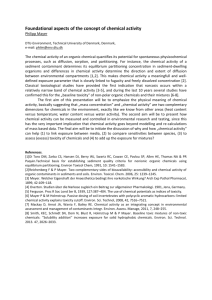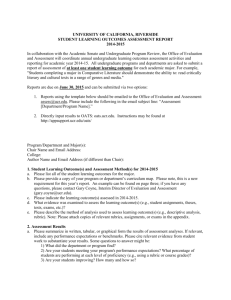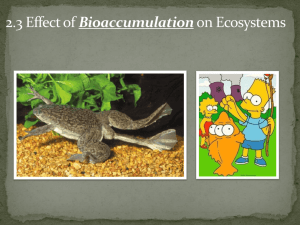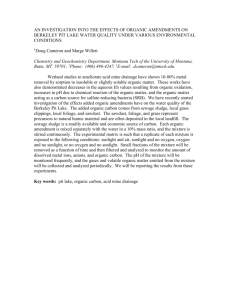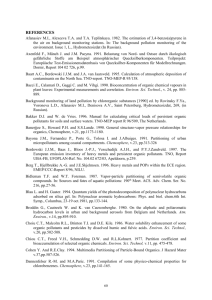To facilitate the characterization promised by this lecture, it is felt
advertisement
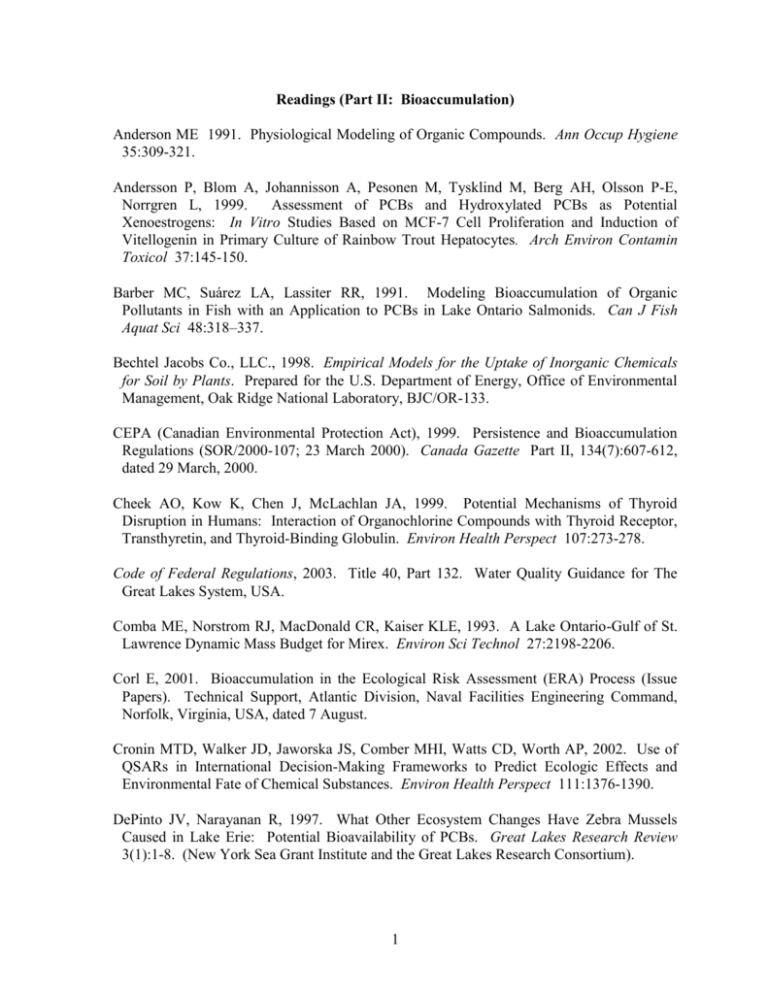
Readings (Part II: Bioaccumulation) Anderson ME 1991. Physiological Modeling of Organic Compounds. Ann Occup Hygiene 35:309-321. Andersson P, Blom A, Johannisson A, Pesonen M, Tysklind M, Berg AH, Olsson P-E, Norrgren L, 1999. Assessment of PCBs and Hydroxylated PCBs as Potential Xenoestrogens: In Vitro Studies Based on MCF-7 Cell Proliferation and Induction of Vitellogenin in Primary Culture of Rainbow Trout Hepatocytes. Arch Environ Contamin Toxicol 37:145-150. Barber MC, Suárez LA, Lassiter RR, 1991. Modeling Bioaccumulation of Organic Pollutants in Fish with an Application to PCBs in Lake Ontario Salmonids. Can J Fish Aquat Sci 48:318–337. Bechtel Jacobs Co., LLC., 1998. Empirical Models for the Uptake of Inorganic Chemicals for Soil by Plants. Prepared for the U.S. Department of Energy, Office of Environmental Management, Oak Ridge National Laboratory, BJC/OR-133. CEPA (Canadian Environmental Protection Act), 1999. Persistence and Bioaccumulation Regulations (SOR/2000-107; 23 March 2000). Canada Gazette Part II, 134(7):607-612, dated 29 March, 2000. Cheek AO, Kow K, Chen J, McLachlan JA, 1999. Potential Mechanisms of Thyroid Disruption in Humans: Interaction of Organochlorine Compounds with Thyroid Receptor, Transthyretin, and Thyroid-Binding Globulin. Environ Health Perspect 107:273-278. Code of Federal Regulations, 2003. Title 40, Part 132. Water Quality Guidance for The Great Lakes System, USA. Comba ME, Norstrom RJ, MacDonald CR, Kaiser KLE, 1993. A Lake Ontario-Gulf of St. Lawrence Dynamic Mass Budget for Mirex. Environ Sci Technol 27:2198-2206. Corl E, 2001. Bioaccumulation in the Ecological Risk Assessment (ERA) Process (Issue Papers). Technical Support, Atlantic Division, Naval Facilities Engineering Command, Norfolk, Virginia, USA, dated 7 August. Cronin MTD, Walker JD, Jaworska JS, Comber MHI, Watts CD, Worth AP, 2002. Use of QSARs in International Decision-Making Frameworks to Predict Ecologic Effects and Environmental Fate of Chemical Substances. Environ Health Perspect 111:1376-1390. DePinto JV, Narayanan R, 1997. What Other Ecosystem Changes Have Zebra Mussels Caused in Lake Erie: Potential Bioavailability of PCBs. Great Lakes Research Review 3(1):1-8. (New York Sea Grant Institute and the Great Lakes Research Consortium). 1 Dong MH, 2001. Toxicologic Epidemiology (A Series of 10 Lectures). Supercourse: Epidemiology, the Internet, and Global Health. [http://www.bibalex.org/supercourse/ toxicology/toxicology.htm]. Endicott DD, Cook PM, 1994. Modeling the Partitioning and Bioaccumulation of TCDD and Other Hydrophobic Organic Chemicals in Lake Ontario. Chemosphere 28:75–87. Ewald G, Larsson P, Linge H, Okla L, Szarzi N, 1998. Biotransport of Organic Pollutants to an Inland Alaska Lake by Migrating Sockeye Salmon (Onchorhynchus nerka). Arctic 51:478-485. Fairchild WL, Swansburg EO, Arsenault JT, Brown SB, 1999. Does an Association between Pesticide Use and Subsequent Declines in Catch of Atlantic Salmon (Salmo salar) Represent a Case of Endocrine Disruption? Environ Health Perspect 107:349-357. Gobas FAPC, 1993. A Model for Predicting the Bioaccumulation of Hydrophobic Organic Chemicals in Aquatic Food-Webs: Application to Lake Ontario. Ecol Model 69:1–17. Kelce WR, Stone CR, Laws SC, Gray LE, Kemppainen JA, Wilson EM, 1995. Persistent DDT Metabolite p,p’-DDE Is a Potent Androgen Receptor Antagonist. Nature 375:581585. Landrum PF, Lydy MJ, Lee (II) H, 1992. Toxicokinetics in Aquatic Systems: Model Comparisons and Use in Hazard Assessment. Environ Toxicol Chem 11:1709–1725. Lee (II) H, 1991. A Clam’s Eye View of the Bioavailability of Sediment-Associated Pollutants. In: Organic Substances in Sediments and Water Volume 3: Biological. (Baker RA, Ed.). Lewis Publishers, Chelsea, Michigan, pp. 73–93. Lien GJ, Gallinat CA, Nichols JW, McKim JM, 1994. Modeling the Accumulation of Three Waterborne Chlorinated Ethanes in Fathead Minnows (Pimephales promelas): A Physiologically Based Approach. Environ Toxicol Chem 13:1195–1205. Lum KR, Kaiser KLE, Comba ME, 1987. Export of Mirex from Lake Ontario to the St. Lawrence Estuary. Sci of the Total Environ 67:41-51. Madsen SM, Mathiessen A, Korsgaard B, 1997. Effects of 17ß-Estradiol and 4-Nonylphenol on Smoltification and Vitellogenesis in the Atlantic Salmon Salmo salar. Fish Physiol Biochem 17:303-312. Madsen T, Lee S, Olle T, 2003. Growing Threats: Toxic Flame Retardants and Children’s Health. Environmental California Research and Policy Center, 3435 Wilshire Blvd., Suite 385, Los Angles, California, USA 90010. 2 Matthews JB, Twomey K, Zacharewski TR, 2001. In Vitro and In Vivo Interactions of Bisphenol A and Its Metabolite, Bisphenol A Glucuronide, with Estrogen Receptors Alpha and Beta. Chem Res Toxicol 14:149-157. McKim JM, 1994. Physiological and Biochemical Mechanisms That Regulate the Accumulation and Toxicity of Environmental Chemicals in Fish. In: Bioavailability – Physical, Chemical, and Biological Interactions. (Hamelink JR, Landrum PF, Bergman HL, Benson WH, Eds.). Lewis Publishers, Boca Raton, Florida, pp. 179–201. Meylan WM, Howard PH, Boethling RS, Aronson D, Printup H, Gouchie S, 1999. Improved Method for Estimating Bioconcentration Factor (BCF) from Octanol-Water Partition Coefficient. Environ Toxicol Chem 18:664-672. Nichols JW, Lien GJ, Hoffman AD, Bertelsen SL, McKim JM, 1991. Physiologically Based Toxicokinetic Modeling of Three Waterborne Chloroethanes in Rainbow Trout (Oncorhynchus mykiss). Toxicol Appl Pharmacol 110:374–379. OECD (Organization for Economic Cooperation and Development), 2002. Test No. 305: Bioconcentration – Flow-Through Fish Test. OECD Guidelines for the Testing of Chemicals, Vol. 1, pp. 1-23, Paris. Roels OA, Lui NST, 1973. The Vitamins: Section A – Vitamin A and Carotene. In: Modern Nutrition in Health and Disease Dietotherapy (Goodhart RS, Shils ME, Eds.). Lea & Febiger, Philadelphia, Pennsylvania, Chapter 5. Suter (II) GW, Efroymson RA, Sample BE, Jones DS, 2000. Ecological Risk Assessment for Contaminated Sites. CRC/Lewis Press, Boca Raton, Florida. Thomann RV, Connolly JP, 1984. Model of PCB in Lake Michigan Lake Trout Food Chain. Environ Sci Technol 18:65-71. UNEP (United Nations Environment Programme), 1998. Preparation of an International Legally Binding Instrument for Implementing International Action on Certain Persistent Organic Pollutants. UNEP/POPS/INC.1/6, Geneva, dated 30 April. U.S. EPA (U.S. Environmental Protection Agency), 1999. Category for Persistent, Bioaccumulative, and Toxic New Chemical Substances. Federal Register 64(213):6019460204. U.S. EPA (U.S. Environmental Protection Agency), 2000. Bioaccumulation Testing and Interpretation for the Purpose of Sediment Quality Assessment: Status and Needs. Bioaccumulation Analysis Workgroup, Washington DC, EPA/823/R-00/001. Veith GD, Macek KJ, Petrocelli SR, Carroll J, 1980. An Evaluation of Using Partition Coefficients and Water Solubility to Estimate Bioconcentration Factors for Organic Chemicals in Fish. In: Aquatic Toxicology (Eaton JG, Parrish PR, Hendricks AC, Eds.). 3 ASTM STP 707. American Society for Testing and Materials (ASTM), Philadelphia, Pennsylvania. Wania F, 1998. The Significance of Long Range Transport of Persistent Organic Pollutants by Migratory Animals. WECC Report 3/98. WECC Wania Environmental Chemists Corp, 289 Simcoe Street, Suite 404, Toronto, Ontario, Canada M5T 2Y5. 4
